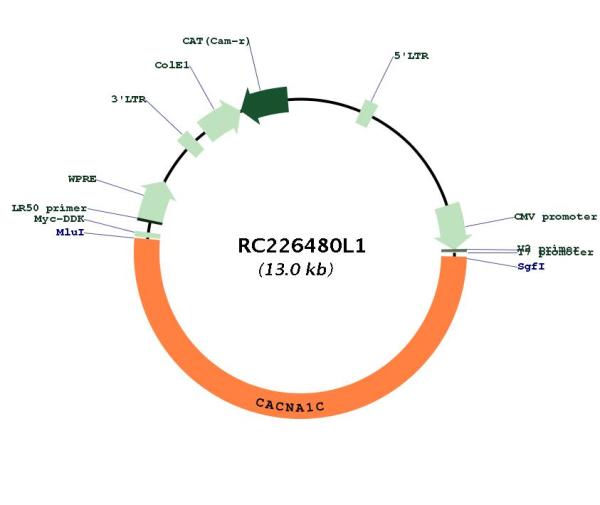CACNA1C (NM_199460) Human Tagged Lenti ORF Clone
CAT#: RC226480L1
- LentiORF®
Lenti ORF clone of Human calcium channel, voltage-dependent, L type, alpha 1C subunit (CACNA1C), transcript variant 1, Myc-DDK-tagged
"NM_199460" in other vectors (4)
Specifications
| Product Data | |
| Type | Human Tagged ORF Clone |
| Tag | Myc-DDK |
| Symbol | CACNA1C |
| Synonyms | CACH2; CACN2; CACNL1A1; CaV1.2; CCHL1A1; LQT8; TS; TS. LQT8 |
| Vector | pLenti-C-Myc-DDK |
| E. coli Selection | Chloramphenicol (34 ug/mL) |
| Mammalian Cell Selection | None |
| Sequence Data |
The ORF insert of this clone is exactly the same as(RC226480).
|
| Restriction Sites |
SgfI-MluI
Cloning Scheme for this gene
Plasmid Map

|
| ACCN | NM_199460 |
| ORF Size | 6663 bp |
| OTI Disclaimer | Due to the inherent nature of this plasmid, standard methods to replicate additional amounts of DNA in E. coli are highly likely to result in mutations and/or rearrangements. Therefore, OriGene does not guarantee the capability to replicate this plasmid DNA. Additional amounts of DNA can be purchased from OriGene with batch-specific, full-sequence verification at a reduced cost. Please contact our customer care team at custsupport@origene.com or by calling 301.340.3188 option 3 for pricing and delivery. The molecular sequence of this clone aligns with the gene accession number as a point of reference only. However, individual transcript sequences of the same gene can differ through naturally occurring variations (e.g. polymorphisms), each with its own valid existence. This clone is substantially in agreement with the reference, but a complete review of all prevailing variants is recommended prior to use. More info |
| OTI Annotation | This clone was engineered to express the complete ORF with an expression tag. Expression varies depending on the nature of the gene. |
| Product Components | The ORF clone is ion-exchange column purified and shipped in a 2D barcoded Matrix tube containing 10ug of transfection-ready, dried plasmid DNA (reconstitute with 100 ul of water). |
| Reconstitution | 1. Centrifuge at 5,000xg for 5min. 2. Carefully open the tube and add 100ul of sterile water to dissolve the DNA. 3. Close the tube and incubate for 10 minutes at room temperature. 4. Briefly vortex the tube and then do a quick spin (less than 5000xg) to concentrate the liquid at the bottom. 5. Store the suspended plasmid at -20°C. The DNA is stable for at least one year from date of shipping when stored at -20°C. |
| Reference Data | |
| RefSeq | NM_199460.2, NP_955630.2 |
| RefSeq ORF | 6666 bp |
| Locus ID | 775 |
| UniProt ID | Q13936 |
| Cytogenetics | 12p13.33 |
| Protein Families | Druggable Genome, Ion Channels: Calcium, Transmembrane |
| Protein Pathways | Alzheimer's disease, Arrhythmogenic right ventricular cardiomyopathy (ARVC), Calcium signaling pathway, Cardiac muscle contraction, Dilated cardiomyopathy, GnRH signaling pathway, Hypertrophic cardiomyopathy (HCM), Long-term potentiation, MAPK signaling pathway, Type II diabetes mellitus, Vascular smooth muscle contraction |
| MW | 248.8 kDa |
| Gene Summary | This gene encodes an alpha-1 subunit of a voltage-dependent calcium channel. Calcium channels mediate the influx of calcium ions into the cell upon membrane polarization. The alpha-1 subunit consists of 24 transmembrane segments and forms the pore through which ions pass into the cell. The calcium channel consists of a complex of alpha-1, alpha-2/delta, beta, and gamma subunits in a 1:1:1:1 ratio. There are multiple isoforms of each of these proteins, either encoded by different genes or the result of alternative splicing of transcripts. The protein encoded by this gene binds to and is inhibited by dihydropyridine. Alternative splicing results in many transcript variants encoding different proteins. Some of the predicted proteins may not produce functional ion channel subunits. [provided by RefSeq, Oct 2012] |
Documents
| Product Manuals |
| FAQs |
| SDS |
Resources
Other Versions
| SKU | Description | Size | Price |
|---|---|---|---|
| RC226480 | CACNA1C (Myc-DDK-tagged)-Human calcium channel, voltage-dependent, L type, alpha 1C subunit (CACNA1C), transcript variant 1 |
USD 2,749.00 |
|
| RG226480 | CACNA1C (tGFP-tagged) - Human calcium channel, voltage-dependent, L type, alpha 1C subunit (CACNA1C), transcript variant 1 |
USD 2,949.00 |
|
| SC311958 | CACNA1C (untagged)-Human calcium channel, voltage-dependent, L type, alpha 1C subunit (CACNA1C), transcript variant 1 |
USD 225.00 |
|
| SC328101 | CACNA1C (untagged)-Human calcium channel voltage-dependent L type alpha 1C subunit (CACNA1C) transcript variant 1 |
USD 2,750.00 |
{0} Product Review(s)
Be the first one to submit a review






























































































































































































































































 Germany
Germany
 Japan
Japan
 United Kingdom
United Kingdom
 China
China


